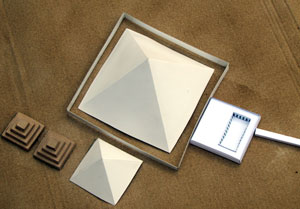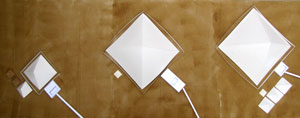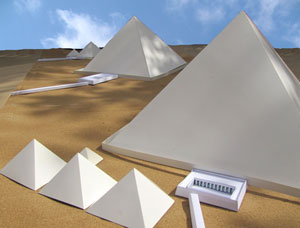
Main activities:
1. Learn about pyramids: different types, their purpose, and the pharaohs buried in them, through photos
2. Try four activities to learn how the pyramids were built - surveying, pulling blocks, building ramps, and making a pyramid from blocks
3. Learn about lives of pyramid builders
4. Make a scale model of the Giza pyramids (with two versions - as they look now, and when first made) and of the Step pyramid
Curriculum links: History (pyramids, pharaohs, gods and religious beliefs of the Egyptians); science (forces, measurement, comparing and testing theories); numeracy (2D and 3D shapes, angles, vertical and horizontal lines and surfaces); art; DT
Note: this workshop involves challenging craft and teamwork activities and is only suitable for fairly able year 5 or 6 classes. If you are unsure, the other Egypt workshops are easier. For all classes extra adult help will be required to ensure successful outcomes (see details below).
To book: email Tony North, tnorth67@hotmail.com or tel: 0161 224 6445
Fee: £299 per class for a whole day. Maximum 30 children per class. Suitable for year 5 and 6.
Teachers' comments: 'a really clear way of illustrating the building of the pyramids'
See more feedback here
Photos from workshops:
Pyramid posters and papyrus sheets for sale at workshops
The Giza pyramids. Built for the burial of three pharaohs, named (right to left) Khufu, Khafre, and Menkaure. The small ones at the front were for Menkaure's wives.
Model of the pyramids made in the workshop.
'Original' version, with white smooth casing stones,
mortuary temples, and causeways (click for larger version)
The Pyramids of Egypt
The Egyptian pyramids were built over 4,000 years ago and over the centuries have inspired as much puzzlement as awe. Why were they built? How could a society with such primitive technology - no iron, no wheels, only stone, wood and copper tools - create monuments which are not only enormous but extremely accurate? The Great Pyramid is the most famous, with over 2 million blocks of limestone, each weighing around 2.5 tonnes, and fitted so well together you can't get a piece of paper between them. Not only that, the greatest difference in length between the four sides (each about 230m) is about 4cm, and the base is level to within 2cm!
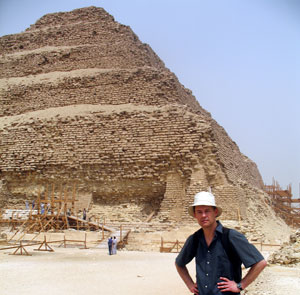
In this workshop children will learn about the mysteries of the pyramids through hands-on experiments in building and levelling, imagining the life of a pyramid builder, and constructing scale models of both the Giza pyramids and the Step pyramid (the very first pyramid - that's me above in front of it). The Giza model can be transformed from its current state to its original, with the original smooth white casings, and the temples for worshipping the dead king. In this way children will gain a rich understanding not only of the shape and scale of the pyramids but of their original meaning to the ancient Egyptians.
A detailed lesson plan is provided in the next column.
Inside the Red Pyramid - the pyramid of Sneferu, father of Khufu.

Khafre's burial chamber

Khufu's sarcophagus

Statue of Khufu, 5cm high - the only existing image of the king

Statue of Khafre, son of Khufu

Statue of Menkaure, son of Khafre, and his wife
‘It was a really clear way of illustrating the building of the pyramids. The children were still commenting on the hands on activities days after.’ - Teacher, Norris Bank Primary, Stockport
'Such a wonderful day! It was obvious that they girls enjoyed themselves, and also that they learned great deal throughout the day' - Teacher, Withington Girls' School
Lesson Plan: Morning
1. Introduction to pyramids and to the day's activities (30 mins)
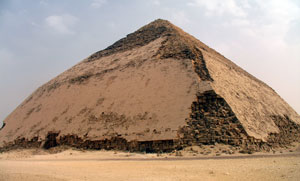
First I will set up the classroom for the later activities. Then we will look at some photos of the more important pyramids in Egypt, and discuss why they were built (as burials for the pharaoh and to send them to the afterlife). Our main focus for the morning however is on the amazing facts of their construction. We discuss ideas about how the pyramids were made, and then how we shall try to find out ourselves with some hands-on activities.
2. Experimental archaeology: Four pyramid building activities (90 minutes)
This activity is a fantastic way for children to get a concrete understanding of pyramid building and the difficulties faced by the Egyptians in making these enormous monuments. Archaeologists often find the best way to understand how people of the past did something is to try it themselves. Children will learn from experience in a similar way, using models. They will think about the results of experiments to make conclusions, which we will as a class at the end.
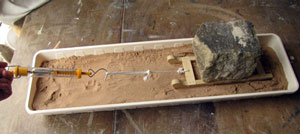
First I will give a demonstration of one activity - showing how difficult it was to pull blocks of stone on different surfaces and slopes, and on a replica of an Egyptian sledge. Two children will help, one pulling the block and one reading a Newton meter to measure the force required. In this way we will see how hard it is to drag a block on sand, on a sledge, on a harder surface, and also on a slope (because the blocks had to be pulled up the pyramids on ramps). Here there are strong links to the forces unit in the science curriculum.
After this children will be divided into 9 groups and work in rotation on 3 activities (with 3 small groups on each activity at one time). These are:
-
Surveying: using replicas of 3 ancient Egyptian surveying tools (plumb line, level, and set square), children will examine surfaces in the classroom to see if they are vertical, horizontal, or right angles. They will think about how these tools might have been used to make the pyramid blocks.
-
Making a ramp: there are many theories about how ramps were built for workers to pull the blocks up the pyramids. Children will test out some theories using wooden models of a pyramid at 2 stages of construction (early and late). They will make ramps with plasticine to see how much material would be required and which method is most stable and effective.
-
Building with blocks: children will try building their own pyramid from strong plaster blocks, to try out methods of stacking, and to see how specially shaped casing stones were needed (and what the types of casing stones are), in order to create the original, smooth look of the pyramids. They will count the different types of blocks and perhaps see a pattern in the numbers required for each level of the pyramid.
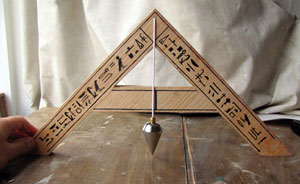
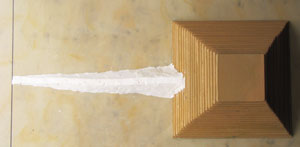

Lesson plan continues in next column

The model the class makes in the afternoon
Plan of Khufu's pyramid, showing queens' pyramids, satellite pyramid, mortuary temple, enclosure wall, and causeway

The pyramids of Menkaure's wives

The Great Sphinx, with Khafre's valley temple front left and the Sphinx temple front right
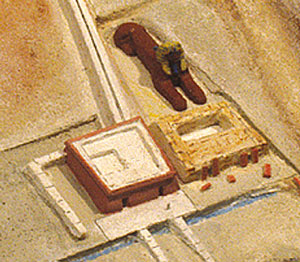
A reconstruction of the Sphinx complex
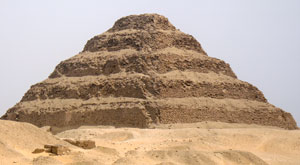
The Step Pyramid
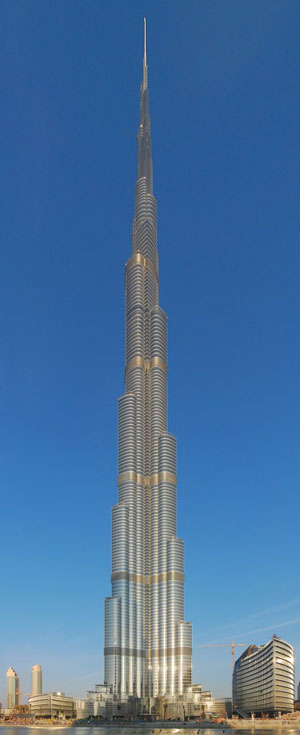
The Burj Khalifa, the tallest building in the world at 829m
The Great Pyramid, at 146m, held this record from 2,500BC to 1300AD
Lesson Plan: Afternoon
1. Lives of the pyramid builders (20 mins)
For many years it was thought the pyramids were built by slaves. We now know this is not true - the builders were mostly ordinary Egyptians, called up to work for months or more at a time, to quarry, pull stones, build ramps, make or sharpen the copper chisels, provide food and water for the workers, and doubtless many other jobs. Some were also highly skilled masons, which we can see from the amazing accuracy of their stonework.
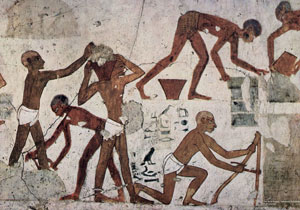
Experts now believe the pyramid builders were highly motivated, happy to work for their pharaoh, to ensure his journey to the afterlife and the goodwill of the gods, so that Egypt would continue to prosper.
In this section of the day, using photos of archaeological findings, we will try to understand what life was like for the builders - their lodgings and food, their work, their medical care and their burial - and discuss whether the evidence shows us that they were slaves or ordinary Egyptians. Note: if time in the afternoon is short we may skip this section so we have time to make the model.

Reconstruction of a bakery at the Great Pyramid.
2. Make a scale model of the pyramids (100+ minutes)
For the main activity in the afternoon, the class will make scale models of the pyramids (1/560th scale). Most of the class will create the Giza pyramids, while a few will make a model of the Step pyramid and the Sphinx with its two temples. Please note that extra adult help is required in order to make the full range of items.
We will make two versions of the Giza model: one as the pyramids are now, darkened with age and lacking their smooth casing stones (except for the top of Khafre's pyramid). This 'current' model can be converted into its original version, with smooth white faces resulting from their specially shaped casing stones (which the children learned about in the morning).
In addition, some children will make the mortuary temples which were a vital feature of the original pyramid complexes, as well as the enclosure walls for the pyramids themselves and the covered causeways which led from these temples to the valley temples.

Remains of Khafre's mortuary temple (his valley temple and sphinx are seen in the background)
This 'original' version will give children a much deeper understanding of why the pyramids were built - as religious centres for ensuring the pharaoh's spirit went to the afterlife, and when there was nourished by the care of the priests in the world of the living.
Making the model will not only teach children about the size, shape and purpose of the pyramids, it will also give them a chance to practise some very important craft skills, such as cutting, gluing, folding and sellotaping. To create this model, accuracy and concentration will be needed, so this is an excellent opportunity to improve these qualities.
Note: due to its complex nature, extra adult help is required for this activity. In addition to myself we will need at least two active adult assistants. If this is not possible, we will omit some of the activities (making the temples, sphinx, enclosure walls and causeways) and instead make more of the modern building pictures. If the children finish the main activities they can make the ones we omitted, or I can leave the resources for you to make them another day.
Making the models
The children will work in small groups, making their own part of the model, as follows:
-
Base - a few children will glue together large pieces of cardboard to create a 240X90cm base for the main model. They will glue on sand to create a more realistic look, and using a template draw a 'map' of where the pyramids will stand.
-
'Current' pyramids - some children will use templates to draw triangles onto light brown, fine corrugated card. They will cut these out, sellotape these together to create the 'stepped' current look of the pyramids. They will make the three main pyramids plus four small, queen's pyramids and two so-called 'satellite' pyramids that stood next to Khufu's and Khafre's pyramids.
-
Small step pyramids - one or two children will paint the two step pyramids thast belonged to Menkaure's queens (these are plaster casts).
-
'Original' pyramids - children will use templates to draw 'nets' onto strong white card, which they will then cut out. These nets are folded and glued into pyramid shapes which fit neatly onto the 'current' versions
-
Mortuary temples - a few children will cut out card nets and fold and glue them to make mortuary temples. These were attached to each pyramid and were the main site for the religious worship of the dead pharaoh. every day priests would offer him sacrifices of animals and other food and drink, as well as giving his statue a clean and a change of clothes. There was a special rite in which they would walk around the pyramid, speaking prayers and offering incense and libations.
-
Enclosure walls and causeways - a few children will complete the pyramid complexes, with the high walls surrounding each pyramid, and the covered walkways which led down to the so-called valley temples.
-
Sphinx and temples - one group will make an example of a valley temple, that of Khafre. Next to Khafre's valley temple was the Great Sphinx, a 73m-long lion-bodied statue of Khafre, as well as a special temple for the sphinx. These are plaster casts which children will paint, gluing on then Sphinx, with a causeway leading back up to Khafre's pyramid.
-
The Step Pyramid - a group of children will make the Step pyramid of King Djoser, by painting a detailed plaster cast.
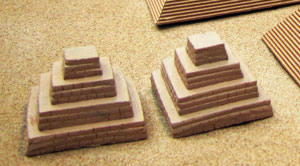
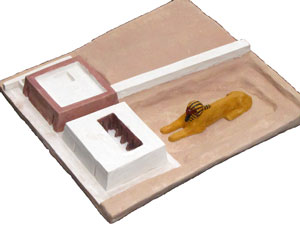
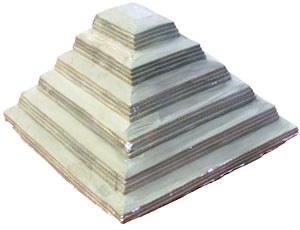
-
Tall buildings - using templates and card, some children will make pictures of a number of buildings, to stick on the wall behind the model and give a sense of the scale of the Giza pyramids. These include smaller buildings such as the White House, Buckingham Palace and Big Ben, and some which have held the record for tallest building in the world. The Great Pyramid (146m) held the record for 3,800 years until 1311 when it was beaten by Lincoln Cathedral (160m). Later record holders include the Washington Monument (169m), the Eiffel Tower (300m), the Empire State Building (381m), the CN Tower (553m), and (currently) the Burj Khalifa in Dubai (829m).






